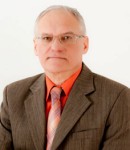
Plenary Lecture
On the Rigid Body Chaotic Transitional Dynamics

Professor Jan Awrejcewicz
Department of Automation and Biomechanics
Lodz University of Technology (TUL)
Poland
E-mail: awrejcew@p.lodz.pl
Abstract: The integral model of dry friction components is built with assumption of classical Coulomb friction law and with specially developed model of normal stress distribution coupled with rolling resistance for elliptic contact shape in order to model a rigid body contact problem. In order to avoid a necessity of numerical integration over the contact area at each the numerical simulation step, few versions of approximate models are developed and then tested numerically. In the numerical experiments the simulation results of the Celtic stone with the friction forces modelled by the use of approximants of different complexity (from no coupling between friction force and torque to the second order Pad? approximation) are compared to results obtained from model with friction approximated in the form of piecewise polynomial functions based on the Taylor series with Hertzian stress distribution. The coefficients of the corresponding approximate models are found by the use of optimization methods as in identification process using the real experiment data.
We show how in the beginning wobbling without slipping and without energy loss have been assumed in a process of modelling and dynamic analysis of the Celtic stone. Then we explore a few paradigm shifts in physics theory aimed at understanding and reliable modelling of the Celtic stone bifurcation and chaotic dynamics: (i) various linearization procedures keeping linear dependence of friction and velocity of a contact point between two bodies; (ii) research through the theory of bifurcation and chaos to explain stability and scenarios of transition between regular and chaotic transitional stone dynamics; (iii) application of the perturbation/asymptotic approaches to study local stone dynamics; (iv) key role of coupling between friction forces and torques assuming a circle contact including both aerodynamic damping and rolling friction factors.
Developments and trends of the state-of-the art of the performed literature survey exhibit importance of the coupling between friction force and torque, which play an essential role in the dynamics of some mechanical systems. If the contact between two bodies is very small (the point contact) the sliding friction force opposes the sliding relative velocity and can be successfully modelled by the use of classical one-dimensional Coulomb friction law. In this case the friction torque (drilling friction) and its influence on sliding friction force can be neglected (since the contact point cannot transmit a torque). Spurious effects observed during the Celtic stone dynamics are also exhibited by a billiard ball, Thompson top, and electric polishing machine, and they cannot be mathematically modelled or explained by the use of the assumption of one-dimensional dry friction model.
Brief Biography of the Speaker: J. Awrejcewicz has been graduated from the Technical University of Lodz in 1977 (Mechanics) and from the University of Lodz in 1978 (Philosophy). He obtained PhD (Habilitation) in 1981 (1990), and he became a Full Professor in 1997. Now he is a chair person of Department of Automation and Biomechanics, a head of a 4-year PhD Study on Mechanics, and a head of the Mechatronics Study at the Technical University of Lodz. His research is focused on Nonlinear Mechanics. J. Awrejcewicz authored and/or co-authored: monographs-42; textbooks-2; edited books-9; editor conference proceedings-12; journal papers-287; conference papers-333; chapters in books-18. He served as an editor of 9 books, and as an Guest-Editor of 15 journal special issues. He supervised 19 PhD theses. He served in Editorial Boards of 33 journals, gave 60 seminars at international universities, delivered 26 plenary/keynote lectures, actively participated at 265 international and 68 national conferences, as well as he was a member of scientific committees of 116 conferences. He spent 10 years abroad carrying out research at University of California, Berkeley, USA (2001); University of Illinois, Urbana Champaign, USA (1999/2000); Tokyo University, Japan (1990-1992); University of Carolo Wilhelmina in Braunschweig, Germany (1987-1990, 1993); ENTPE, Lyon, France (1995, 2005); Central European University, Budapest, Hungary (2003/2004); Waikato University, Hamilton, New Zealand (1996/1997). J. Awrejcewicz obtained the Humboldt Research Award, Germany, 2011; MASTER Grant Award, Foundation for Polish Science, 2010-2012; Golden Lamp Award (PGNiG) in Technical Sciences, Poland, 2006; awards of the Ministry of Science and Education for monographs in 1996, 2004, 2006, 2008.